 25 October 2016
2016- n° 273In October 2016, the economic climate is stable in the building construction industry Monthly survey of building - October 2016
25 October 2016
2016- n° 273In October 2016, the economic climate is stable in the building construction industry Monthly survey of building - October 2016
According to the business managers surveyed in October 2016, the business climate is stable in the building construction industry. The composite indicator holds steady at 96, below its long-term average (100). It has remained close to this level since April 2016.
According to the business managers surveyed in October 2016, the business climate is stable in the building construction industry. The composite indicator holds steady at 96, below its long-term average (100). It has remained close to this level since April 2016.
graphiqueGraph1 – Business climate composite indicator
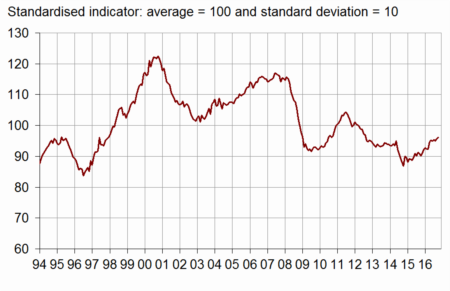
graphiqueGraph2 – Turning-point indicator
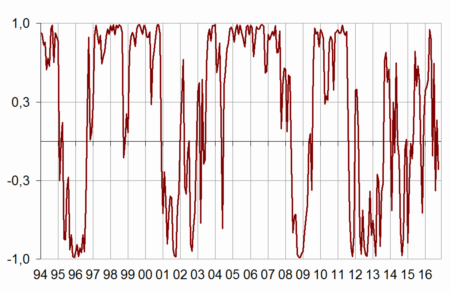
Business managers' opinion about their past activity has improved
In October 2016, many more business managers than in September have forecast an increase in their past activity. The corresponding balance of opinion has come back above its long term average for the first time since May 2016. Their opinion about the general outlook in the sector has been virtually stable compared with July, the corresponding balance of opinion has remained above its long term average. Finally, the balance of opinion on activity for the next three months has slightly decreased, albeit staying above its long term average.
graphiqueGraph3 – Activity tendency in building construction
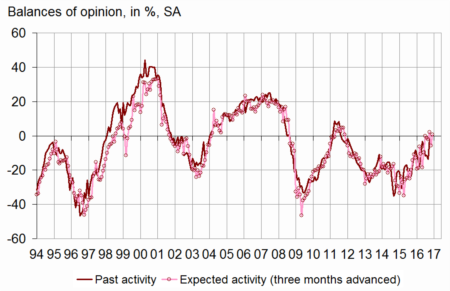
tableauTable1 – Balances of opinion, in %, SA
| Mean* | July 16 | Aug. 16 | Sept. 16 | Oct. 16 | |
|---|---|---|---|---|---|
| Composite indicator | 100 | 95 | 95 | 96 | 96 |
| Past activity | –4 | –12 | –11 | –14 | –2 |
| Expected activity | –7 | 2 | –6 | 1 | –1 |
| Gen. business outlook | –19 | –6 | –5 | ||
| Past employment | –6 | –21 | –22 | –20 | –22 |
| Expected employment | –5 | –14 | –14 | –9 | –10 |
| Opinion on order books | –24 | –45 | –41 | –38 | –40 |
| Order books (in month) | 5,4 | 6,9 | 6,9 | 6,9 | 6,9 |
| Production capacity utilisation rate | 88,5 | 86,5 | 87,2 | 86,6 | 86,7 |
| Obstacles to production increase (in %) | 32 | 23 | 25 | 22 | 24 |
| - Because of workforce shortage (in %) | 14,0 | 3,9 | 4,3 | 3,4 | 4,1 |
| Recruiting problems (in %) | 57 | 45 | 47 | ||
| Expected prices | –15 | –23 | –21 | –19 | –20 |
| Cash-flow position | –10 | –8 | –13 | ||
| Repayment period | 30 | 32 | 36 |
- * Mean since September 1993.
- Source: INSEE, French business survey in the building industry
Business managers are slightly more pessimistic about their employment prospects
In October 2016, slightly fewer business managers than in September have planned to increase their staff size over the next three months. The corresponding balance of opinion remains far below its long-term average. The balance of opinion on past staff size has slightly declined, thus remaining at a level well below its long-term average.
graphiqueGraph4 – Workforce size tendency in building construction
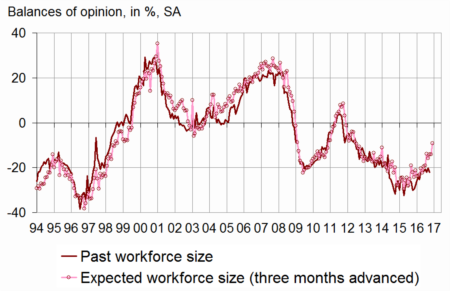
Business managers continue to deem their order books very low: the corresponding balance has decreased for the first time since May 2016 and stays far below its long-term average. With their staff size, business managers consider that their order books provide 6.9 months of work, the same level as last month and above its long-term average (5.4 months).
graphiqueGraph5 – Opinion on order books
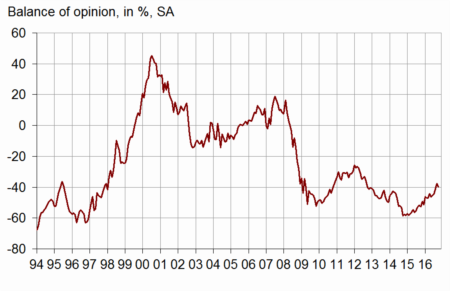
Since 2008, the production capacity utilisation rate has been lower than its long-term average (88.5%). However, it has recovered gradually since early 2015. In October, it has barely increased (+0.1 point) and reached 86.7%. About one business manager out of four has reported difficulties in increasing output, compared to one out of three in average since 1993. Furthermore, 47% of business managers have experienced difficulties in recruiting labor force against 57% in long term average.
graphiqueGraph6 – Production capacity utilisation rate
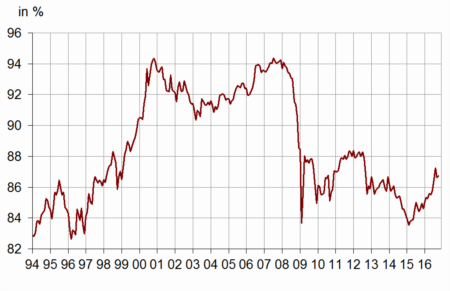
In October 2016, almost as many business managers as in September have announced that they were going to reduce their prices during the next three months. The corresponding balance remains below its long-term average. More business leaders than in the previous quarter have indicated that their cash-flow position has deteriorated. The corresponding balance has returned below its long term average. More business managers than in the previous quarter have reported that the repayments periods have been tending to get longer.
Documentation
Methodology (2016) (pdf,170 Ko)




